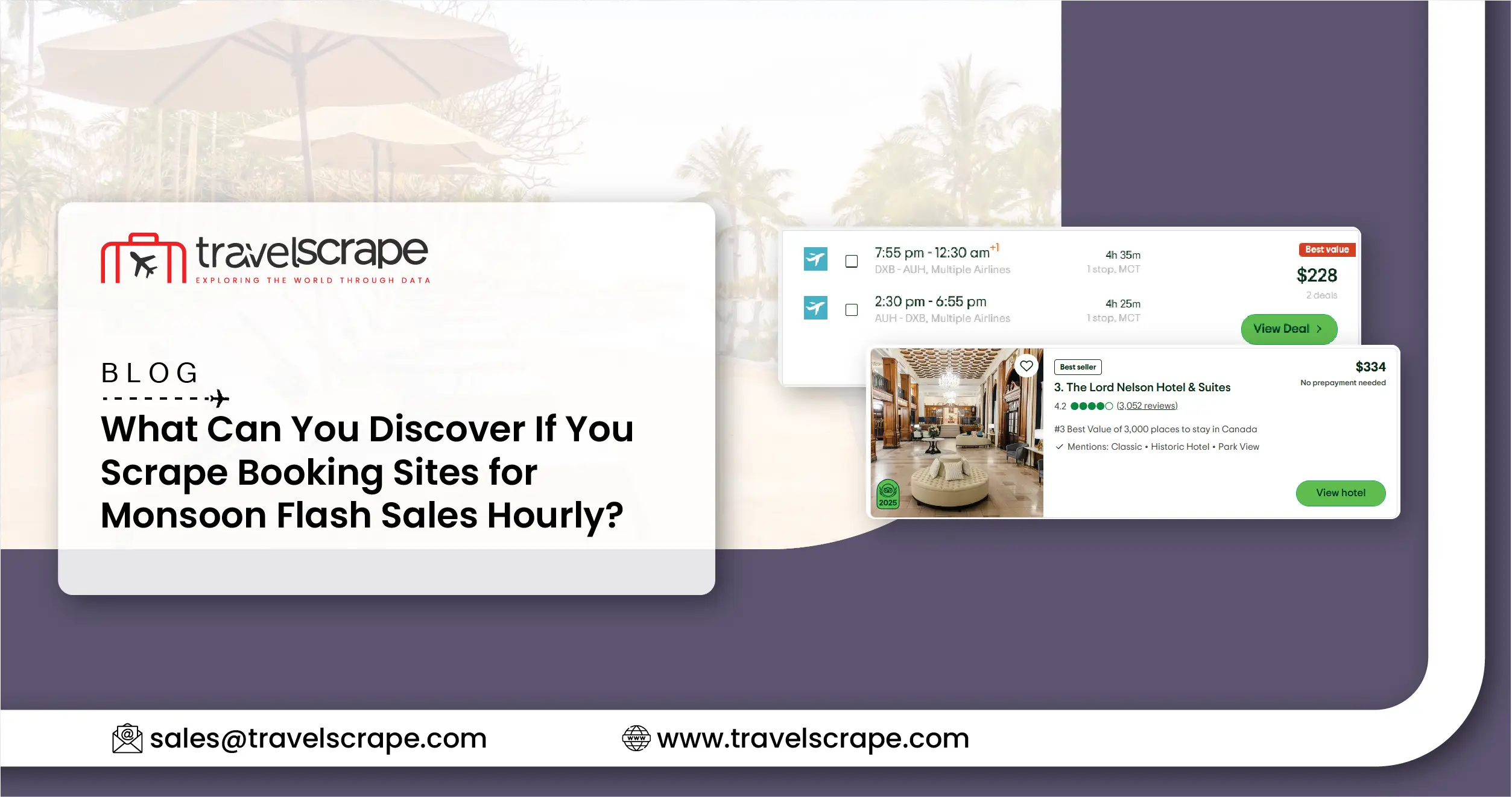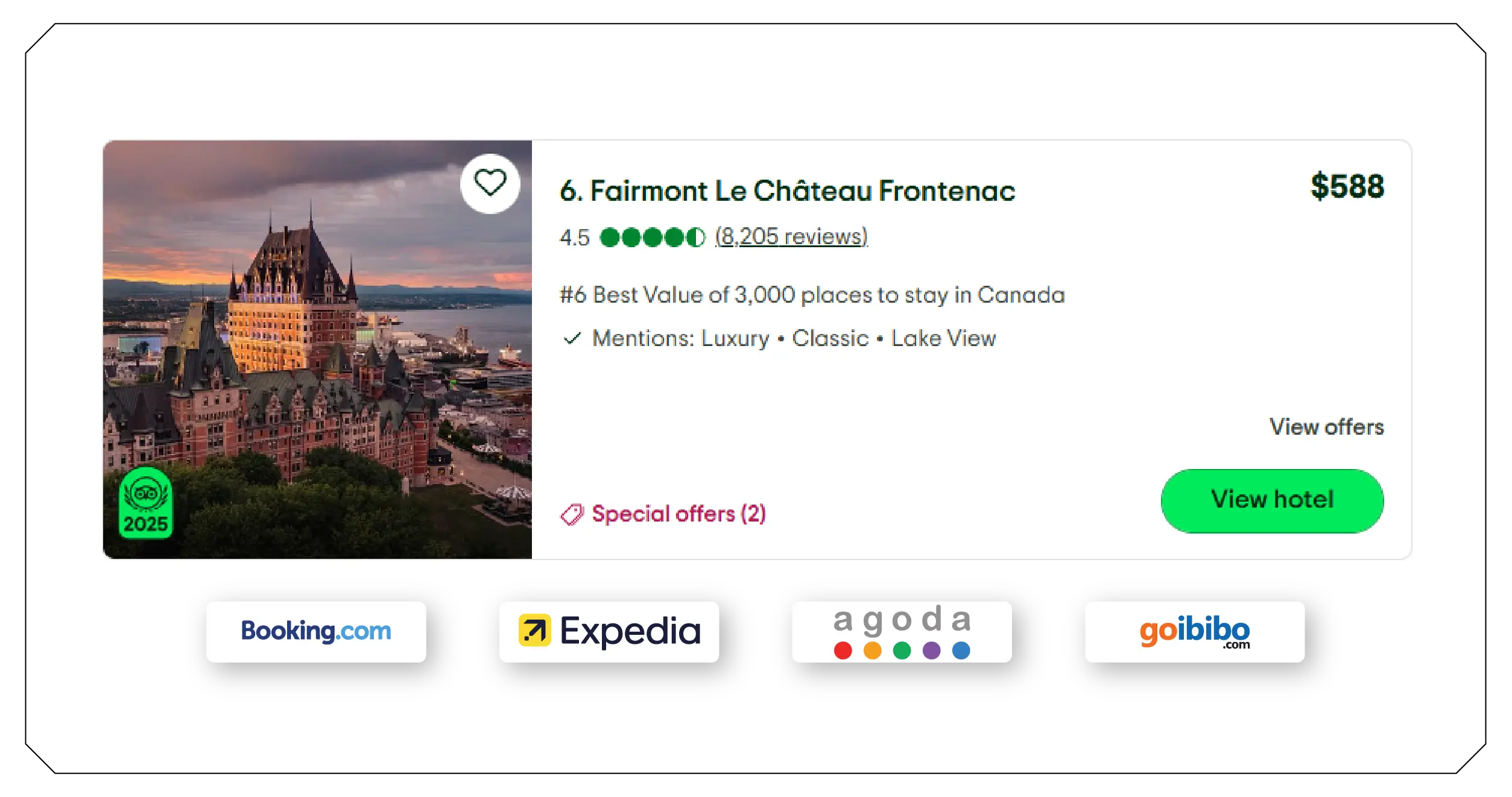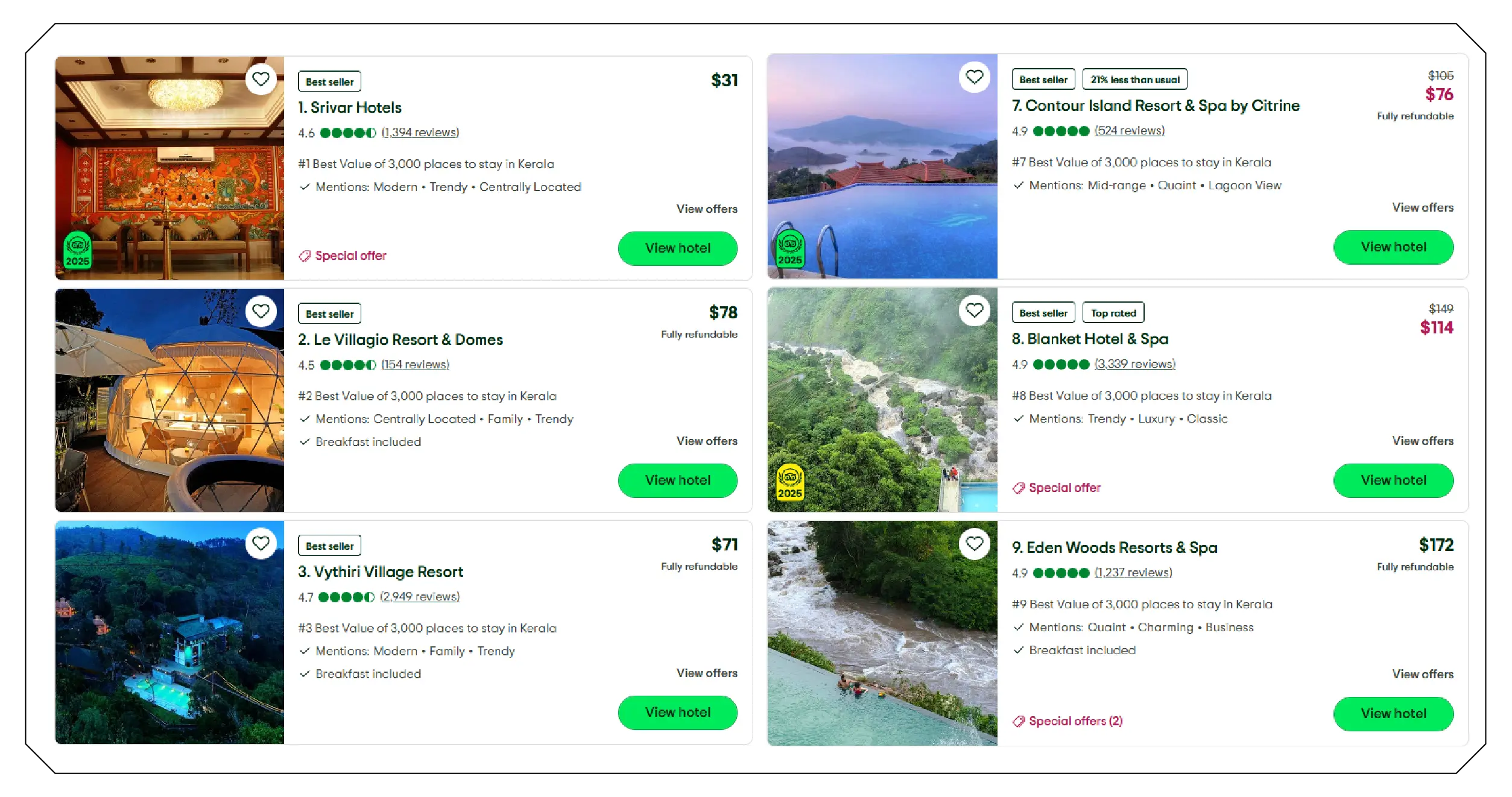What Can You Discover If You Scrape Booking Sites for Monsoon Flash Sales Hourly?

Introduction
Monsoon season brings more than just rain and romance—it brings lightning-fast flash sales on travel bookings. Hotels, airlines, and booking platforms slash prices in real-time, offering deals that disappear within hours. But the big question is: Which travel sites drop prices the fastest? And how can you stay ahead of the curve?
The answer lies in leveraging advanced technologies to Scrape Booking Sites for Monsoon Flash Sales. By capturing and analyzing price fluctuations across top booking portals, travelers and businesses alike can monitor seasonal trends, identify which platforms respond quickest to changing demand, and secure the best offers before they’re gone.
Today’s travelers are smarter, and so are the tools they use. With Travel Deal Price Scraping , one can scan thousands of listings per hour—from beachfront resorts to mountain retreats—filtering out the noise and isolating only those with steep, time-sensitive markdowns.
Whether you’re a tech-savvy backpacker, a travel startup, or a deal aggregator, automated tools like Hotel Price Drop Monitoring Tools ensure you never miss out on these monsoon gems. These systems track historical data, monitor competitor pricing, and notify users the moment a price plunges below expected thresholds.
Why Flash Sales Matter During Monsoon Travel?

Monsoon flash sales aren’t just random markdowns. They’re part of a wider strategy by travel brands to fill up slow-season inventory. Rainy months typically see lower tourist volumes in many regions, prompting platforms like Booking.com, Expedia, Agoda, and Goibibo to unleash price wars.
Using a Flash Sale Travel Sites Scraper, businesses can track how frequently and how significantly these drops occur. For example, a hotel in Goa may drop rates by 45% overnight. Such deals often don’t appear on search engines—they’re hidden in app-only deals, geo-targeted offers, or last-minute push notifications.
To catch these elusive deals, you need a Real-Time Travel Fare Scraping API that scans listings every few minutes. This ensures that your data remains fresh, capturing flash sales that last only an hour or two.
Which Booking Sites React Fastest to Seasonal Price Changes?
By comparing booking data during monsoon months, patterns begin to emerge. Some platforms update hotel and flight prices every few hours; others rely on daily refreshes. When you Scrape Hotel Flash Sales Data, you can observe which sites offer:
- The most frequent markdowns
- Deepest price cuts during off-peak hours
- Geo-specific discounts tied to weather or seasonality
For example, Indian platforms like MakeMyTrip or Yatra may update flash deals more aggressively during Indian monsoons compared to global sites like Hotels.com. These trends are critical for budget travelers and price comparison engines alike.
Implementing a scalable Travel Web Scraping Service ensures that you’re capturing this dynamic data across all regions and providers. With the right tools, you can track price movements hourly across hundreds of cities and hotel chains.
Key Data Points to Track While Scraping Flash Sales
When developing a monsoon flash sale data pipeline, the following data points are crucial:
- Original price vs. current deal price
- Timestamp of price change
- Discount percentage
- Duration of deal visibility
- Booking platform and listing source
- Geo-tagged hotel or flight location
This is where a powerful Travel Scraping API proves essential. It extracts structured data and funnels it into BI dashboards or travel apps, enabling users or internal systems to trigger alerts, view trend maps, or even automate bookings.
Additionally, these tools enable aggregation across categories such as room types, flight classes, or vacation packages, providing a unified view of seasonal discounts.
Detecting Real-Time Price Volatility During Monsoon Months

One of the most significant advantages of flash sale scraping is understanding Real-Time Travel Data volatility. You’ll be able to map how monsoon-related conditions (e.g., storm alerts or flooding news) influence flash sales, cancellations, or new availability on travel portals.
A price drop detected at 9 AM in Kerala may indicate an overnight drop in demand due to weather disruptions. When paired with weather data or news alerts, this becomes a powerful forecasting model.
For platforms aiming to build automated deal alert engines, combining scraped data with Travel Trends & Advisories adds a contextual layer that makes alerts more relevant and actionable. You won’t just know prices dropped—you’ll understand why.
How Travel Data Scraping Trends Are Evolving?
The evolution of Travel Data Scraping Trends shows a move toward hyper-personalized scraping models. Instead of scraping all listings, modern tools filter results based on user preferences, such as pet-friendly, beachfront, or free cancellation.
Another trend is AI-enhanced scraping, which identifies listings likely to go on sale soon based on historical price drop behavior, occupancy patterns, and seasonality. This proactive scraping is revolutionizing deal prediction.
Furthermore, regional players are also becoming more savvy. Airlines Data Scraping has revealed that some budget airlines launch secret monsoon flash sales—available only through app usage or newsletters. By scraping airline websites directly, businesses can track these offers even before they’re publicized.
The Rise of Intelligent Flight Price Analytics
Beyond hotels, monsoon flash sales are just as aggressive in the airline industry. By using Flight Price Data Intelligence , travelers can identify which airlines respond most quickly to changes in demand. For instance, AirAsia and IndiGo may offer price drops within minutes of unsold inventory, while others wait for batch updates.
Real-time flight scraping systems give users the ability to:
- Monitor multi-city flight deals
- Track fare reductions on specific routes
- Match flight deals with monsoon events (festivals, weather alerts)
These insights aren’t just valuable for end-users—they’re invaluable for affiliate marketers, comparison websites, and travel fintech apps offering credit-backed flash booking.
Comparing Booking Platforms: A Case Study
Imagine monitoring hotel prices across 10 platforms in Mumbai during the first week of August. Here’s what scraped data might reveal:
| Platform | Avg. Price Drop | Time to Update Prices | Most Discounted Room Type |
|---|---|---|---|
| Agoda | 22% | Every 6 hours | Deluxe Double |
| Booking.com | 18% | Every 4 hours | Standard Room |
| Goibibo | 28% | Every 2 hours | Executive Room |
| Expedia | 15% | Every 8 hours | Suite |
| Yatra | 30% | Hourly updates | Budget Room |
This type of insight is only possible through consistent scraping and historical price tracking across platforms.
Unlocking Competitive Edge with Scraping

Whether you're launching a flash sale aggregator, building a browser extension, or analyzing travel price trends, scraping unlocks insights that no human could gather at this scale. By detecting micro-deals during monsoon, you gain competitive edge and predictive visibility.
It also enables B2B services—your scraped datasets can be monetized by selling to travel agents, affiliate partners, or advisory platforms. With ethical and structured scraping, you build a data pipeline that serves real market needs.
How Travel Scrape Can Help You?
- Custom Web Scraping Solutions
We build tailored scraping scripts to extract hotel, flight, and vacation rental data from top booking platforms like Booking.com, Expedia, and Agoda. - Real-Time Price Drop Monitoring
Our tools track flash sales and price changes in real time, helping users capture the best deals as they appear. - Geo-Targeted Travel Deal Extraction
We extract location-specific offers and discounts, ideal for regional analysis or targeted travel marketing. - Structured Travel Data via API
We deliver clean, organized booking data through scalable APIs, making it easy to integrate into apps, dashboards, or BI tools. - Historical Travel Price Analysis
We help businesses analyze trends over time by scraping and storing booking data, enabling smarter forecasting and decision-making.
Conclusion
Monsoon is no longer a slow season—it’s a season of smart deals, and those who act quickly win. But identifying these limited-time offers across platforms demands automation, strategy, and the right tools.
By leveraging a Flight Price Tracking Scraping Script, travel platforms and individual users can detect fare drops instantly and act faster than competitors.
Implementing a robust framework for Scraping Monsoon Travel Discounts also helps travel agencies personalize deals, optimize marketing, and drive seasonal bookings effectively.
To do this right, you need a powerful Booking Site Price Drop Scraper that monitors hotel and airline websites 24/7 for the latest monsoon deals.
As more booking platforms compete on price agility, only those with real-time visibility will be positioned to win. And scraping is the lens through which that visibility becomes actionable.
Ready to elevate your travel business with cutting-edge data insights? Get in touch with Travel Scrape today to explore how our end-to-end data solutions can uncover new revenue streams, enhance your offerings, and strengthen your competitive edge in the travel market.
.webp)
.webp)